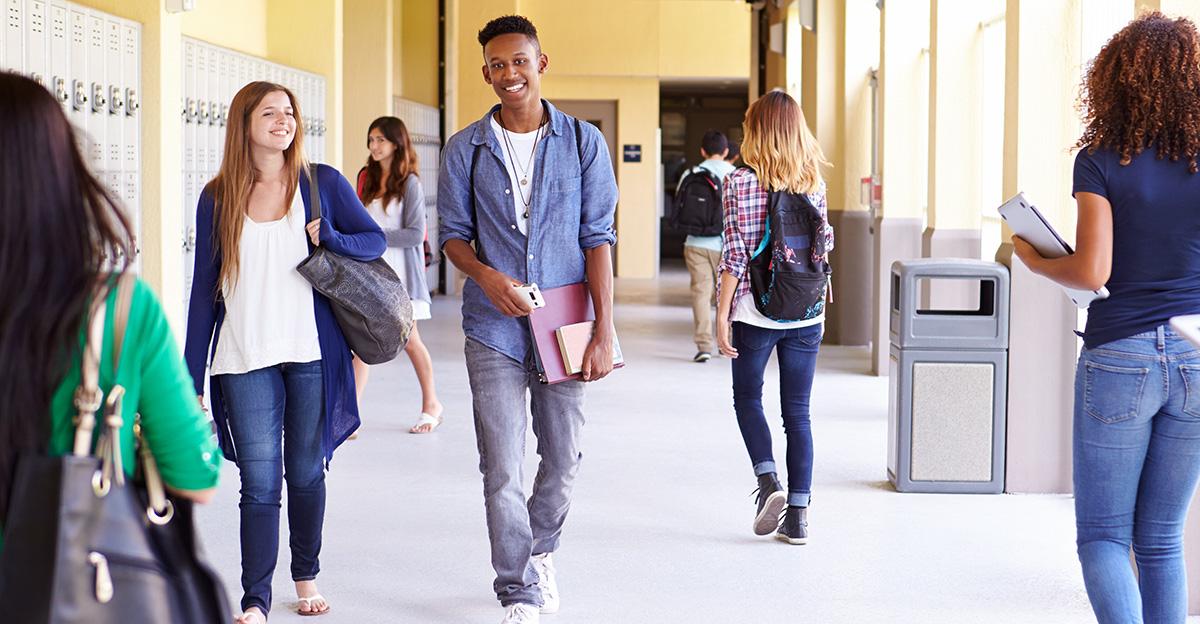It’s the worst nightmare of every student, parent, and educator: hearing the alarm or announcement that signifies a school lockdown.
According to Education Week, there were 49 incidents of gunfire on school grounds in the United States in 2018 and 2019. That figure dropped to 10 in 2020, as nearly all schools shifted to remote instruction for at least part of the year, but it went back up to 35 in 2021.
Overall, schools are still very safe places. From 1992 to 2018, the rate of crimes (theft and/or violence) committed against students ages 12-18 while they were at school declined by more than 80 percent, from 181 victimizations for every 1,000 students in 1992 to just 33 per 1,000 students in 2018. However, the design of a school building can make it even safer.
Schools don’t have to resemble fortresses to keep students safe. With simple yet purposeful design elements and school security features, K-12 leaders can create safe and secure facilities that are also welcoming learning environments.
Let’s take a closer look at three key design elements for keeping students safe in school: access control, visibility, and connection.
Access Control
Controlling who’s allowed to access the building is one of the most basic steps in making schools safer. And there are many design strategies that can help prevent unwanted intruders from entering. Here, we break this concept down into three subcategories.
Entrances
Limiting the number of entrances and exits used during school hours makes it easier to control access to the building. We recommend designating a single point of entry for faculty and staff—ideally protected by a keypad, keycard reader, or biometric identification system such as a fingerprint, palm, or facial recognition reader—and a separate entry for students. This advice is supported by Security Magazine’s article on keys to securing K-12 campus entries. If you have the personnel to do so, consider stationing a security or school resource officer (SRO) at the student entrance equipped with two-way radio communications while students arrive.
Students or staff who come to school late should use the visitor entrance. This entry should have direct access to the school’s office, such as through a video intercom that allows office staff to see who’s requesting access before remotely opening the door. A video intercom helps prevent “piggybacking,” Security Magazine notes, which is when an unannounced guest tries to enter along with an approved visitor.
Adding a secure vestibule is also a best practice that prevents unwanted guests from directly accessing the school’s interior. The inner doors should have security film or other protective hardening attributes wherever there is glass.
Controlling access also includes proper screening for potential threats. There are a wide variety of walkthrough and handheld metal detector solutions from which to choose. Don’t forget about remotely located school activities and sporting events—consider portable units for placement at these events, both indoor and outside, as well as multiple zone metal detectors for more precise measuring.
Visitor access management
A visitor access management system helps school leaders understand who’s in their building while screening out potentially dangerous intruders. An added benefit is that staff know how many visitors they have in the building in the event of an emergency evacuation.
The system can be as simple as requiring visitors to sign in and wear a badge, or it can involve more comprehensive security. For example, visitors might be required to show a government-issued ID that’s compared with criminal databases and sex offender registries before being granted access to the main facility. Or, they might be subjected to a palm, fingerprint, or facial recognition scan that can effectively assist in registering each guest or even account for all persons present, including students and staff.
Door security
Doors should be kept locked when not in use. If this isn’t practical, schools must have a way to immediately secure each classroom door. Quick Action Lockdown locks are a best-practice example of a lockset that requires no special knowledge, key, or tool to initiate an immediate lockdown. This series of locksets prevent intruders from accessing the classroom by simply pressing the red button to deploy a one-inch stainless steel deadbolt. Students and staff will always know the status of the lock by viewing the lock indicator. These locksets are 100% code compliant, always maintaining a single motion egress capability, and they allow first responders or administrators to reenter with a controlled master key.
Classroom doors aren’t the only doors with which school leaders need to be concerned. Many school spaces are controlled by “exit devices” or push-bar doors. These doors often control larger spaces such as cafeterias, libraries, gymnasiums, and auditoriums. An additional challenge is that these spaces usually have multiple doors. One answer to this challenge is the Lexi Lockdown door security system, which allows school leaders to lock multiple doors simultaneously. This system secures all your exit devices in that space with the press of a wall-mounted, under-desk, or desktop panic-style alarm button—or even the press of a pendant button worn by a staff member. Doors controlled with Lexi Lockdown are 100% code compliant and retrofit to existing door trims.
Don’t forget about outside exit doors that aren’t used for regular egress. These should be outfitted with an exit device alarm that has an audible sound when opened or propped open. This can be a local alert or tied to an existing alarm system.
As a final thought on door security, consider how staff office spaces will be secured. The Quick Action Lockdown locksets can be installed on office doors or doors to a designated “safe room,” such as a conference room where staff can relocate in the event of an intruder situation.
Visibility
Having visibility into what’s happening in and around the school is another important factor in keeping students and employees safe. School planners and designers can create a safer environment by establishing clear sight lines within hallways and common areas and by avoiding nooks and recesses in which someone can easily hide. Incorporating open, airy spaces into the building’s design can contribute to a safe and inclusive school culture. Here, we break this important subject into four subcategories.
Exterior
School designers can take advantage of Crime Prevention Through Environmental Design (CPTED) principles to enhance visibility and promote safety. CPTED is an approach that suggests the design of buildings and outdoor environments can either encourage or discourage crime.
For instance, landscaping can be used to reduce access to unsupervised locations on school property. Strategic use of windows that overlook the school’s entrance provides opportunities for natural surveillance while letting potential bad actors know that others can see them clearly as they approach the building.
Although windows are perfect for letting in natural light and for improving the visibility of the school’s perimeter, they also let potential intruders see into the building and can provide an open line of sight to students or faculty. Adding blinds or shades that can be drawn quickly should be considered as additional protection from extreme weather events, as well as a way to screen occupants from persons intent on doing harm.
Interior
Lockdown shades for your interior classroom windows and sidelights are must-have security features—and in some states, they’re now a requirement. These items are designed to prevent intruders from viewing and targeting students and staff from interior hallways, and the horrific events at Marjory Stoneman Douglas High School in Parkland, Florida, demonstrate their value. In the Parkland shooting, the attacker never entered a single occupied classroom but engaged students and staff by shooting through the unobstructed interior windows and sidelights, as well as at people in the hallways and stairwells. Weighted lockdown window shades provide a simple, cost-effective solution for covering windows quickly in the event of an emergency.
In large classrooms or open areas where these shades might not be practical, architects or school leaders often design or create “safe zones,” which are areas that are either out of the line of sight from windows or behind a safety wall. HMC Architects creates safe zones with different colors or patterns of flooring, so students can easily know they’re in a non-visible area. You might also strategically place everyday teaching items, such as whiteboards, to obstruct a clear line of sight into the classroom.
Cameras
Surveillance cameras can also increase visibility within the building and on school grounds. IP-based video cameras can be viewed from any internet-connected device, and network video recorders record and store all camera images. However, consideration must be given to the pragmatic use of cameras. For instance, will they be monitored in real time, or will they just record images for processing later? We suggest they be used both ways by monitoring during critical times and later processing data or events as appropriate for your operations. Linking the camera system to a smart sensor (see the next section for more details) could also prove critical.
Monitoring
Visibility can mean more than just seeing. The monitoring of air quality, light, and sound is just as important. The HALO IoT Smart Sensor fills gaps in a building’s “visibility” by monitoring private areas where cameras aren’t allowed, such as bathrooms. This device provides a comprehensive warning system for hazards to school health and security. It tracks air quality to combat infectious diseases, as well as detects and notifies about the presence of vaping, temperature changes, loud disturbances, seismic activity, and more. HALO can even recognize the chemical signature of spray paint and markers to help prevent graffiti. It has a real-time gunshot detection capability, and the HALO Help feature allows for immediate communication with first responders to reduce response times. Plus, the HALO Cloud option lets you manage multiple HALOs at once to detect trends and generate reports for your whole facility or school system.
Connection
School security isn’t just about keeping intruders out of the building and off school grounds. It’s also about establishing the right culture. According to Design Principal James Krueger of HMC Architects, “Creating a safe campus starts with helping students feel cared for and valued.” The threats to students and faculty don’t just come from outside; they can also come from within. However, when students feel connected with each other and with the adults in the building, they’re less likely to erupt in violence.
Encourage interaction
The design of the school can help foster this sense of connection. Include open, communal spaces with seating options designed to support conversation. Encourage teacher-student interaction by ensuring clear walkways for teachers to circulate around the room, listen to conversations, and offer help as needed. Inspire student collaboration through the use of mobile desks and tables that can be arranged into flexible group sizes, such as the Classroom Select Concord series of student desks that can easily be configured into groups of two to six.
Help each other in an emergency
Cultivating an environment of caring should also include a plan to help each other in the event of an emergency, such as a school attack or—more likely—an accidental injury on school grounds. One potential scenario that schools should be prepared for is an injury resulting in severe bleeding. Arterial bleeding can prove fatal within three to five minutes if not controlled.
This is why many school administrators and security directors are deploying public-access bleeding control stations throughout campus. These stations contain the lifesaving bleeding control measures and just-in-time training necessary to protect students, staff, and visitors from a severe bleeding event. Mobilize Rescue System kits are paired with a diagnostic phone app to ensure that untrained rescuers always have the knowledge they need to save lives. Schools adopting these solutions have recorded several life-saving rescues.
Read More on 21st Century Safe Schools
Although the culture of a school is fundamental in maintaining safety and security, its design plays a critical role as well. Visit our website to learn how School Specialty can help you design safe school facilities, learning environments, and classrooms that engage and inspire students.
Joe Wilson
Joe Wilson leads School Specialty’s Safety and Security Business Development for the East region. A retired Pennsylvania State Police lieutenant, S.W.A.T. commander, and Deputy Police Chief, Joe is a graduate of the prestigious FBI National Academy for law enforcement executives and an Army veteran.
Mike Simler
Mike Simler leads School Specialty’s Safety and Security Business Development for the West region. Mike has more than 30 years of experience in both public law enforcement and private-sector security and investigative services.








Leave a Reply